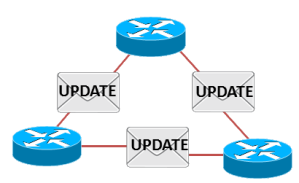EIGRP… The Basics

- EIGRP Neighbor – EIGRP router sends Hello messages which discover potential neighboring routers that are running EIGRP. This checks that basic parameters to decide which routers should be neighbors. (You can view the neighbors by issuing the command show ip eigrp neighbor)
- Topology Table – When routers are EIGRP neighbors they exchange full topology tables when they are first neighbors, and then only partial updates as needed when the network topology changes. (You can view the topology table by issuing the command show ip eigrp topology)
- Routing Table –Each router that has a topology table analyzes its own topology table and chooses the lowest cost value to reach each route that has been advertised. (You can view the routing table by issuing the command show ip route)
If routers are connected to each other and exchange topology information then the following must be true:
- They pass the authentication process
- They both uses the same configured AS number
- The source IP address used by the Hello messages are in the same subnet
- The EIGRP K Values match
Some other information about EIGRP is that the hello and update messages that EIGRP sends use a multicast IP address of 224.0.0.10. EIGRP uses metrics called Bandwidth, delay, reliability, and load. By default EIGRP uses bandwidth and delay but these values can be changed and added into EIGRP's metric calculation. That's my quick rundown on EIRGP, Check back often as I will have some configuration examples up and go in a little deeper into the EIGRP like talking about successors and feasible successors. I hope this information is helpful and if you have questions please post them. Summary of EIGRP and OSPF
Feature
EIGRP
OSPF
Converges Quickly
YES
YES
Built-in Loop Prevention
YES
YES
Sends partial routing updates
YES
YES
Classless, supports manual summarization
YES
YES
Allows manual summarization at any router
YES
NO
Sends routing information using IP multicast on LANs
YES
YES
Uses the concept of a designated router on a LAN
NO
YES
Flexible network design (no need to create areas)
YES
NO
Support equal and unequal load balancing
YES
NO
Metric based on bandwidth delay
YES
NO
Can advertise IP, IPX and AppleTalk routers
YES
NO
Public standard
YES/NO***
YES
** *Some this information was provided by visiting the following link:http://www.cisco.com/en/US/tech/tk365/technologies_white_paper09186a0080094cb7.shtml **Odom, Wendell. CCNA ICND2 Official Exam Certification Guide . 2nd. Indianapolis: Cisco Press, 2008. 380-402. Print. *** RFC 7868 https://tools.ietf.org/html/rfc7868 (Informational)
Related articles
- Configure Router on a Stick (lewiryan.github.io/ciscoskills)
- Debugging a single EIGRP neighbor (gatestec.wordpress.com)
- EIGRP Basic Concepts (learnnetworkingwithme.wordpress.com)
- When to reboot a Cisco router? (gatestec.wordpress.com)
Comments:
Networking (Types of Connection, RING TOPOLOGY) Part-2 « myreviews -
[...] EIGRP… The Basics (lewiryan.github.io/ciscoskills) [...]